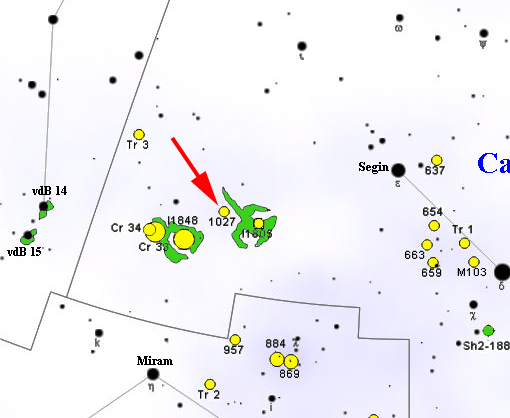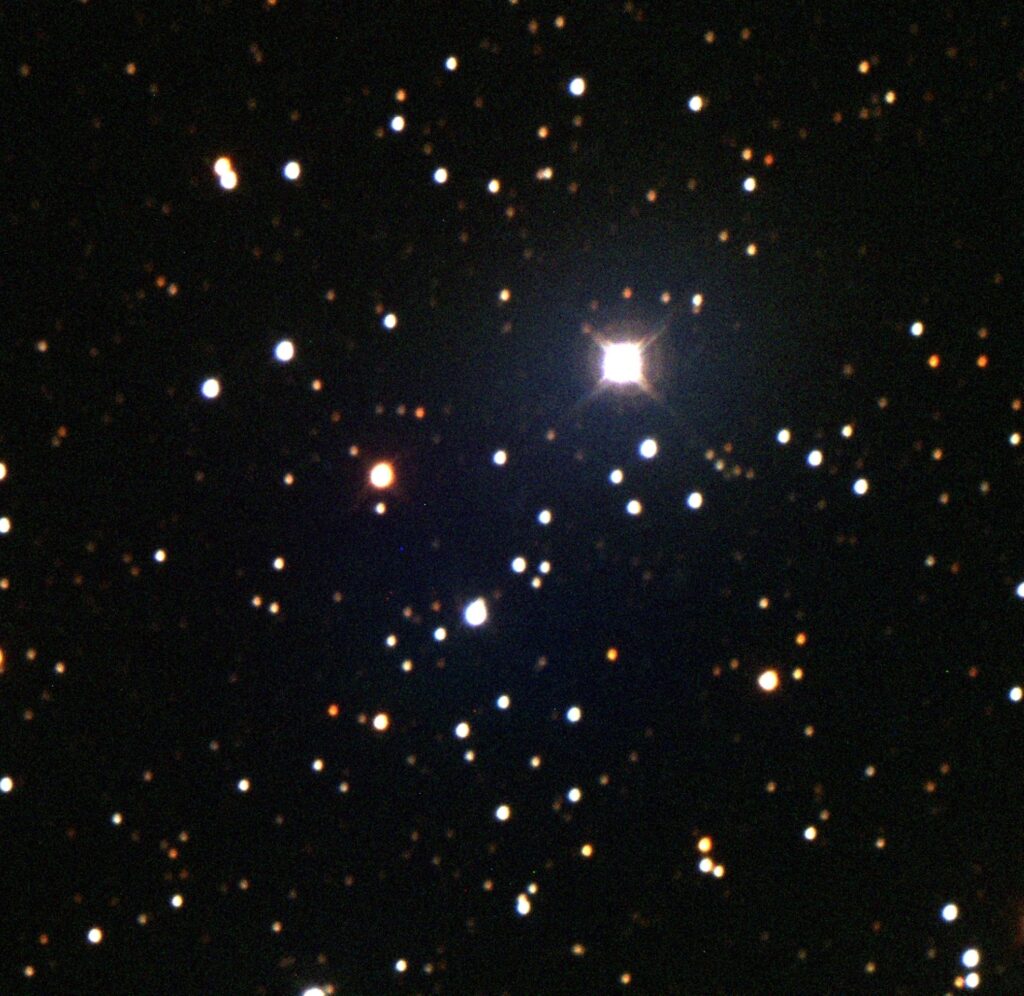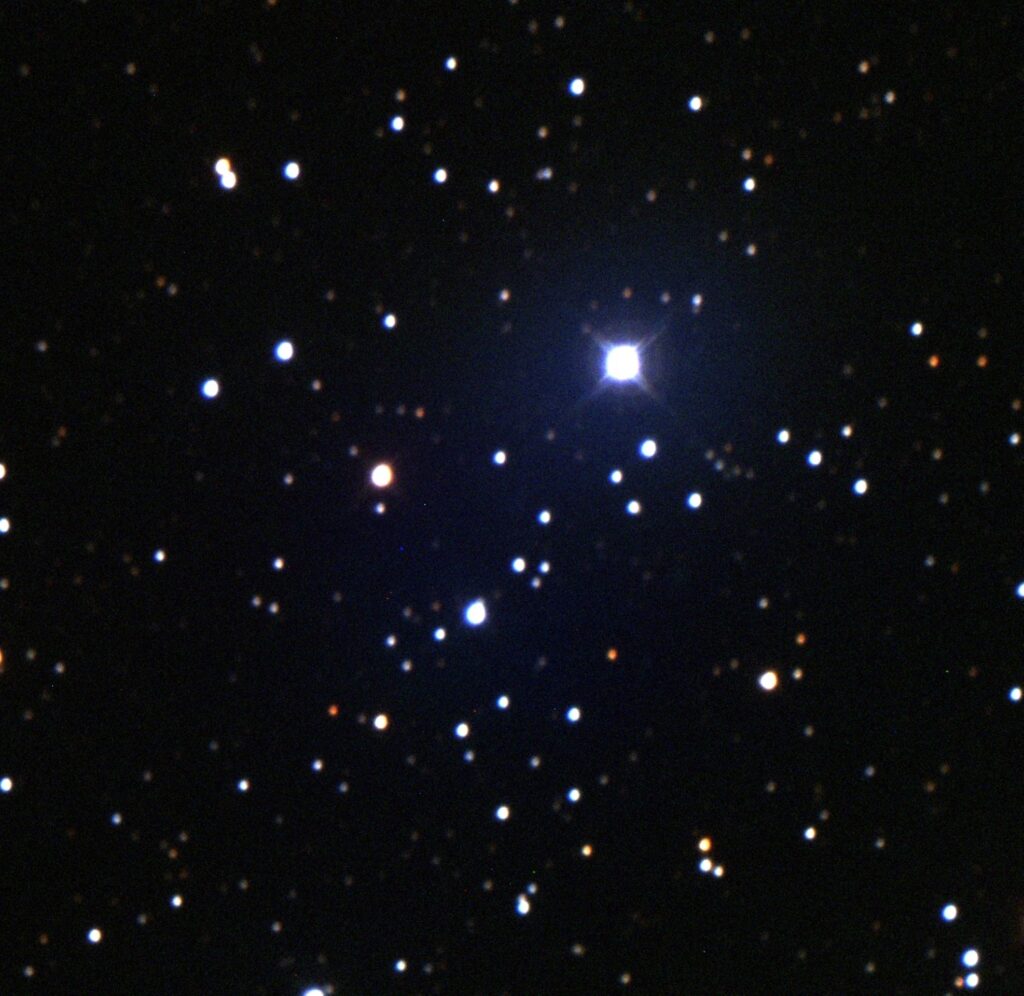Dylan Wilson
WVT792
‹Introduction›
NGC 1027
NGC 1027 is an open star cluster of intermediate age located within the northern constellation of Cassiopeia, named after Queen Cassiopeia, the mother of Andromeda in Greek mythology. NGC 1027 was discovered by German-British astronomer and composer William Herschel in 1787. NGC 1027 can be observed in the Cassiopeia constellation, in between two emission nebulae named Heart and Soul Nebulae; however, the NGC 1027 cluster is not connected with the two nebulae.
New studies and information pertaining to the NGC 1027 cluster may be found on page 87 in Craig Crossen and Gerald Rhemann’s 2012 book Sky Vistas: Astronomy for Binoculars and Richest-Field Telescopes. They state that the apparent magnitude of the cluster is 6.7 and that it can be seen with 10×50 binoculars around a 7th magnitude star that is not part of the cluster, and that the brightest member of the cluster has an apparent magnitude of 9.3.
(Interpretation of the Cassiopeia constellation produced by Roberto Mura, 25 July 2013, 17:06:33.
You can see the 1027 cluster in between both nebulae and the location of the cluster and nebulae within the Cassiopeia constellation.)

‹Data›
I collected 9 exposures in the filters gprime, iprime, rprime, zprime, B, V, R, and lastly I. With the exposures, I analyzed NGC 1027 and investigated the correlations between the colors and brightnesses, as well as the age and chemical composition of the cluster in its entirety. My total exposure duration for each filter was 60 seconds, and I made use of Skynet, utilizing the Sleaford PROMPT-USASK telescope to position the telescope at RA 02:42:42.4 and Dec 61:36:57.5. I utilized Afterglow and Cluster Pro Plus to create a graph portraying my estimates and edit the captures of the NGC 1027 to bring it realistic colors. I estimated that its proper motion in RA (mas/yr) was -1.785 ± 0.686 (mas/yr). Proper Motion in Dec(mas/year) was 2.058 ± 1.265 (mas/year). The distance was 0.92 kpc.The error% was 40.93%, log(age) was 6.99, and E(B-V) was 0.53.
‹Observations›
(Captures taken of NGC 1027 using Sleaford PROMPT-USASK then edited with Afterglow.)

(Same observation but also includes the de-redden image of 0.53, my estimated E(B-V))

‹Graphs›
(Graphs created utilizing data gathered from GAIA and the values gathered by MWSC rather than the values I estimated.)

(Graphs created in Cluster Pro Plus, utilizing data taken from the exposures I took of NGC 1027.)

‹Conclusions & Additions›
Most of the isochrones were fairly close together, so the data in both graphs looked fairly similar, which made me feel pretty good as it displayed that the data I gathered was actually accurate to a degree, but it appears I was overly conservative in my giving and taking of the unit of measure of log (age), as my estimate and the MWSC have a relatively sizable gap. There also appears to be a sprinkling of blue stragglers.
Values comparison:
MWSC: log(age) = 8.55 | Metallicity = 0 solar | E(B-V) = 0.25 mag
ESTIMATE: log(age) = 6.99 | Metallicity = -1.57 solar | E(B-V) = 0.53 mag
The process of gathering information for my cluster, as well as the means of data collection and the whole exercise, was quite fascinating. Overall, I’m really satisfied with every aspect of this project; I never anticipated to find research to be so fun and engaging, nor have I had projects upon which I felt as strongly engaged as I did in the handful of in-depth activities we undertook during the course.
Written by Dylan Wilson,
WVT792,
03/27/2023
Sources:
MWSC data spreadsheet, line 267